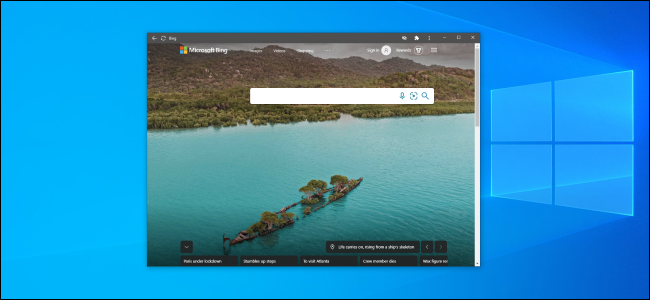If you access certain websites regularly, you can turn them into native Windows 10 apps. This lets you use your sites as if they were normal apps. You can use Google Chrome or Microsoft Edge to create these apps, and we’ll show you how.
How Website Apps Work
Your website looks and works exactly the same in your app as it does in your web browser. The only difference you’ll see is that there won’t be any browser elements in your app window, such as the bookmarks bar, address bar, and other toolbar elements.
If you use Chrome, the website app will be using Chrome in the background. If you use Edge, the browser app will use Microsoft Edge. However, normal browser elements are stripped off so that you get the actual app-like experience. These web apps get their own separate windows, taskbar icons, and desktop shortcuts.
Turn a Website into an App Using Google Chrome
You can use Chrome’s main menu to turn any website into a Windows app.
To start making your app, open the “Start” menu, search for “Google Chrome,” and click the browser in the results.
First, open any website that you want to turn into an app. Navigate to the specific web page that you want your app to start with.
When the site has loaded, click the menu button (three dots) in the top-right corner of the window and select More Tools > Create Shortcut.
A prompt will appear asking for your new app name. Enter a name for your new app, enable the “Open as window” checkbox, and click “Create.”
Chrome will create the app for your site and add it to the Start menu. You can now search and launch your app using your PC’s Start menu.
Create an App for a Website with Microsoft Edge
You can also use Microsoft Edge to make a website into an app. This creates the exact same kind of app that Chrome does. After all, Microsoft Edge and Chrome are both based on the same underlying open-source Chromium code.
To create your app in this browser, launch the “Start” menu, search for “Microsoft Edge,” and click the browser.
Navigate to the website that you want to make an app for, then navigate to the specific page that you want to use for the app.
Now, click the menu button (three dots) in the top-right corner of the window and select Apps > Install this site as an app.
Type a name for your new app, then click “Install.”
You can now launch your newly created app from the Start menu.
Create a Desktop Shortcut for Your Apps
Your website apps will have their own shortcuts in your Start menu’s All Apps list. You can also create a desktop shortcut for your apps in order to quickly access them on your PC’s desktop, if you like.
If you used Chrome to make your apps, your desktop shortcuts are already created. But if you used Microsoft Edge, you’ll need to manually add shortcuts to your desktop.
To do this, open the “Start” menu and search for your newly created app. Right-click your app and select “Pin to Start.”
You need to do this because Windows doesn’t let you directly make a shortcut for this kind of app.
Open the “Start” menu again, and you’ll see your app on the right. Drag it over to your desktop and a shortcut for it will be created.
How to Create a Taskbar Shortcut for Your Apps
You can also make a taskbar shortcut for your website apps.
To do this, open the “Start” menu, search for your app, right-click your app, and select “Pin to taskbar.”
How to Assign an Icon to Your Website Apps
By default, Windows uses your website’s favicon as the icon for your app. You can change this icon if you want to give a little makeover to your new app.
You can use an icon file from your computer or one of Windows 10’s built-in icons for your new app.
To change your app’s icon, right-click your app shortcut on your desktop and select “Properties.”
In the Properties box, click “Shortcut” at the top, and then click “Change Icon.”
Click “Browse” in the window that opens and select the icon that you want to use for your app.
If you want to use one of Windows 10’s stock icons, browse to the C:WindowsSystem32 folder and double-click the “imageres.dll” file in this folder.
You’ll see a list of Windows 10’s built-in icons. Select the one that you want to use and click “OK.”
To save your settings, click “Apply” and then select “OK.”
How to Uninstall Website Apps
Like with other regular apps, you can uninstall a website app if you no longer plan to use it. This won’t affect your account with the website, and you’ll continue to be able to use the site from your web browser.
To begin removing your app, first, launch the app on your PC.
Click the three dots on the title bar at the top of the window and select “Uninstall.”
Click “Remove” in the prompt to remove the app.
Did you know that you can use this method to access Apple Notes on your Windows PC? This makes an app that works and feels just like the actual Notes app found on Apple’s iPhone, iPad, and Mac devices.



















